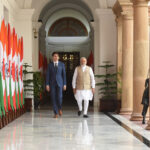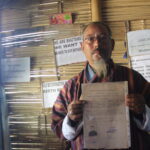The Biden administration released its long-awaited Nuclear Posture Review (NPR) yesterday, amidst growing tensions with Russia over its invasion of Ukraine and with China over perceptions of its potential threat to Taiwan. The document is a disappointment, but perhaps to be expected in the midst of the new Cold War-like climate enveloping Washington, DC.
The review is a business-as-usual document that misses the opportunity to modernize US nuclear doctrine in ways that would reduce the risks of a nuclear conflict. Rushing tactical nuclear weapons to Europe, doubling down on the Pentagon’s decades-long, $2 trillion plan to build a new generation of nuclear weapons, and backing off from earlier statements about moving to a policy of only using nuclear weapons to deter or respond to nuclear threats or nuclear use by an adversary carry the seeds of a new nuclear arms race. The current US arsenal is more than sufficient to deter any nation from attacking the United States. Building more nuclear weapons is both excessive and dangerous.
THE SILVER LINING, PERHAPS?
In a press release issued the day of the NPR release, the Arms Control Association pointed out in its initial analysis of the document there is at least one silver lining, which is that the NPR emphasizes nuclear arms control, nuclear nonproliferation, and risk reduction. Not only is this vital because the New START nuclear arms treaty expires in less than three and half years, but also because “the risk of nuclear weapons use in the context of Russia’s war on Ukraine is as high as any time since the Cuban Missile Crisis 60 years ago.”
The review is a business-as-usual document that misses the opportunity to modernize US nuclear doctrine in ways that would reduce the risks of a nuclear conflict.
One question will be when the United States and Moscow can begin serious consultations on a follow-on to the New START treaty, which expires in 2026. Direct communication between the two nations has been minimal, to put it mildly, since Russia’s February 2022 invasion of Ukraine, and the Biden administration’s main response to Russian nuclear threats has been to say loudly and clearly that there will be severe consequences if the Putin regime goes that route. But at some point, there will have to be discussions of what a new arms control agreement might look like, what it should include, and how it might be verified.
Even during the height of the Cold War, there was a US-Soviet hotline, and more recently, in Syria and at the start of Russia’s war in Ukraine, the United States and Russia had deconfliction protocols to avoid a direct confrontation between the two nuclear-armed powers. But the climate in Washington for talking to Moscow about virtually anything may be at an all-time low. Until that obstacle is overcome, arms control initiatives between the countries that possess the vast bulk of the world’s nuclear weapons will not be possible.
As for China, the review repeats the claim that it is likely to roughly quadruple its current arsenal of strategic nuclear weapons to around 1,000 warheads by the early 2030s. This assertion is speculative at best. And as the Federation of American Scientists has noted in its analysis of the Chinese nuclear program, “even if the Chinese stockpile quadrupled in size, it would still only make up a fraction of the US and Russian stockpiles.” Rose Gottemoeller, former US Undersecretary of State for Arms Control and International Security and chief US negotiator for the 2010 New Strategic Arms Reduction Treaty, has indicated, “there is no need to panic,” because China has “a long way to go to catch up with the United States.” It would be far better for Washington to engage in dialogue with China on the size, shape, sophistication, and strategy governing the two sides’ nuclear forces than to stumble into a costly and risky arms race.
FULL SPEED AHEAD!
All of the above arguments are mustered in service of the plan to go full speed ahead with the Pentagon’s plan to build a new generation of nuclear weapons. But they ignore the critical point noted above, that the United States has far more nuclear weapons than it needs to dissuade any nation from launching a nuclear attack on it. This point is set out in detail in the alternative nuclear posture proposal developed by the organization Global Zero, which calls for a “deterrence-only” strategy that eschews elaborate nuclear warfighting doctrines and scenarios.
Advocates of arms control and disarmament have a tough road ahead, but their efforts are more crucial than ever at a time of nearly-unprecedented nuclear tensions. Growing public fears of a nuclear confrontation need to be channeled into support for practical measures to reduce the nuclear danger, as occurred in the upsurge of anti-nuclear activities during the 1980s, from the million-person rally in Central Park to the Nuclear Weapons Freeze Campaign. There is much work to be done, and the time to double down on building a public breakwall against a new nuclear arms race is now.
William D. Hartung is a senior research fellow at the Quincy Institute or Responsible Statecraft.





















